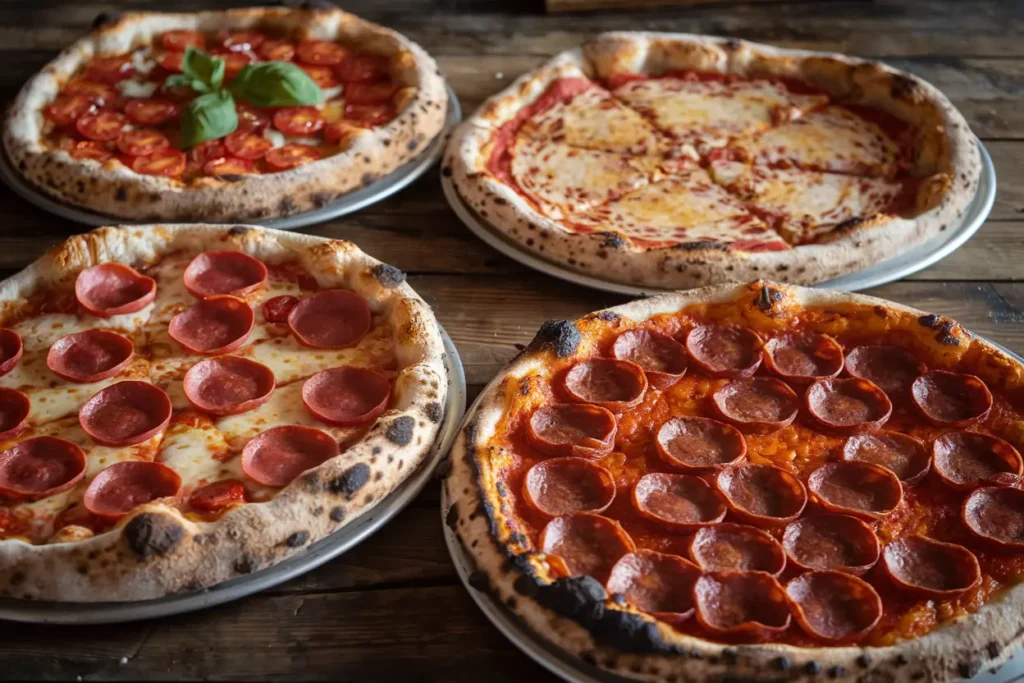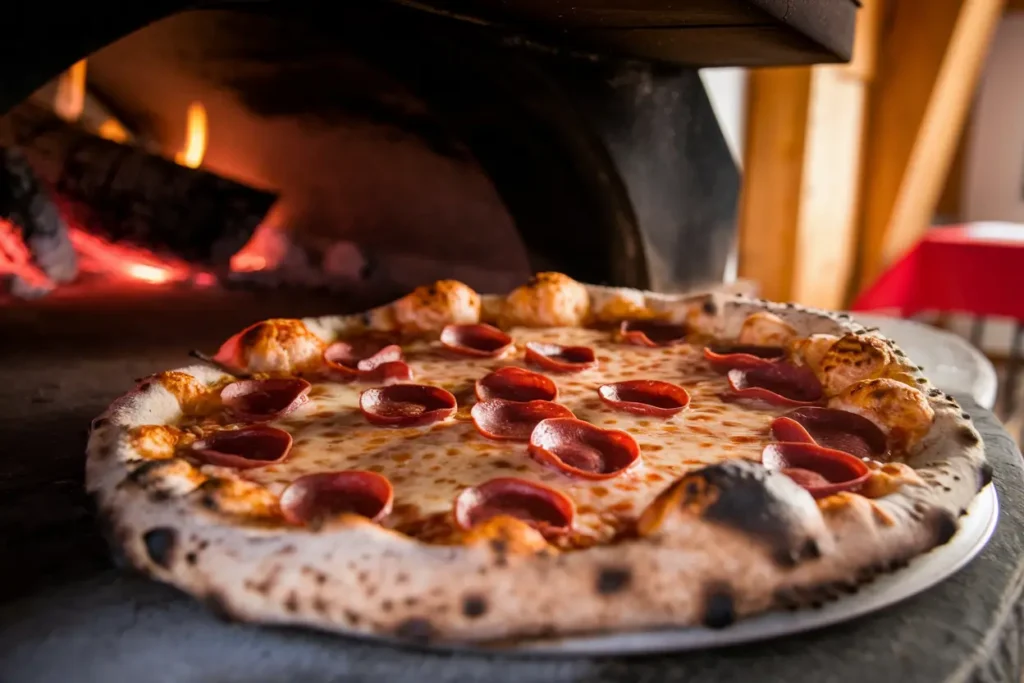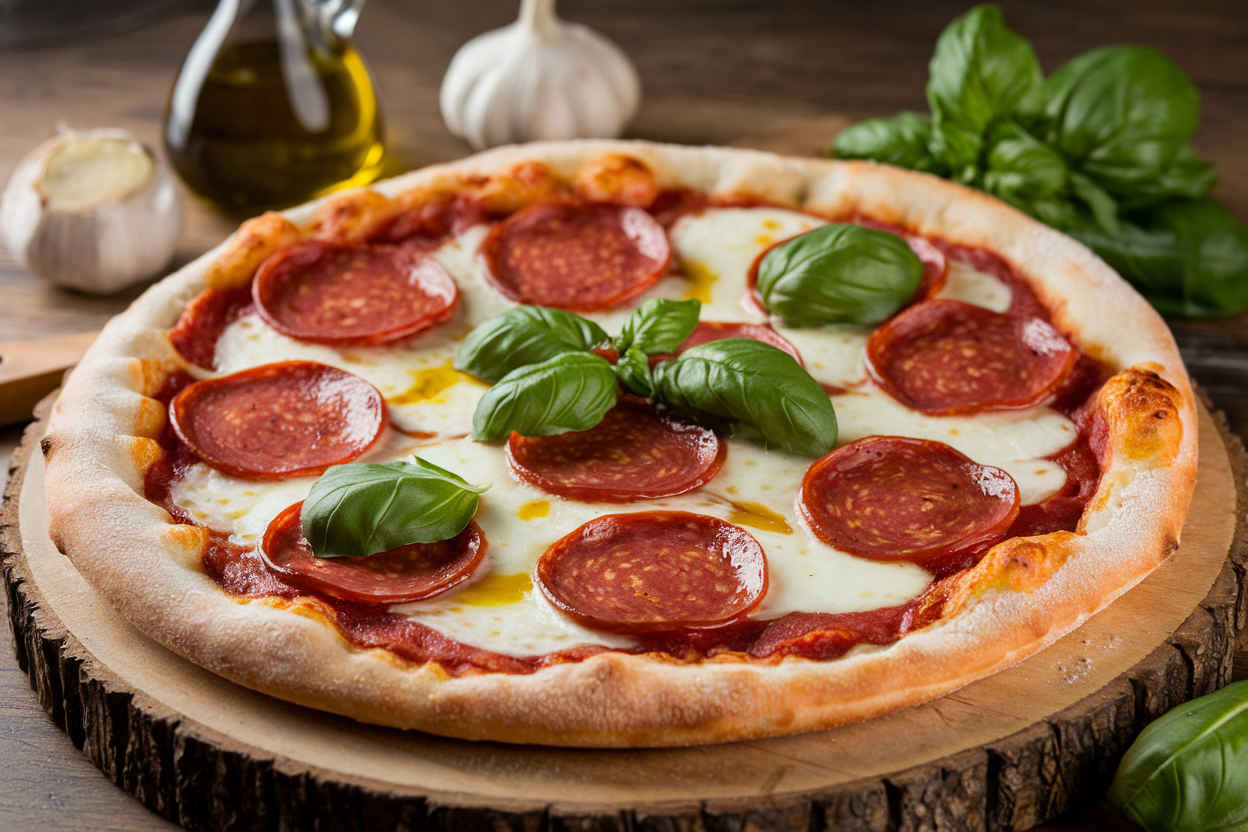Pizza is one of Italy’s greatest culinary gifts to the world, and nothing embodies its magic quite like an Italian Pepperoni Pizza. With its perfect balance of a thin, crispy crust, rich tomato sauce, creamy mozzarella, and bold, smoky pepperoni, this pizza is a delicious fusion of tradition and flavor. In this guide, we’ll show you how to create an authentic Italian pepperoni pizza at home, complete with tips and techniques that capture the essence of Italy in every bite.
The magic of Italian pizza comes to life during the baking process. While a wood-fired oven is ideal for authentic results, you can achieve an incredible pizza with your home oven by following these tips.
Table of contents
- Preheating Your Oven for Optimal Results
- How Long to Bake Your Pizza
- The Finishing Touches
- Regional Variations of Pepperoni Pizza in Italy
- Common Issues and Solutions
- Advanced Techniques for Italian Pizza Enthusiasts
- Baking Your Italian Pepperoni Pizza to Perfection
- Regional Variations of Pepperoni Pizza in Italy
- Common Issues and Solutions 🤔🍕
- Advanced Techniques for Italian Pizza Enthusiasts 🧑🍳✨
- Creative Presentation Ideas for Your Italian Pepperoni Pizza 🍴✨
- FAQs About Italian Pepperoni Pizza ❓🍕
- Conclusion: Embrace the Art of Italian Pizza 🍕❤️
- From Authentic to Gourmet: Exploring Pepperoni Pizza Creations
Preheating Your Oven for Optimal Results
For the best crust and texture, preheat your oven to its highest setting—usually around 500°F (260°C). Place a pizza stone or steel on the middle rack while the oven heats up. A preheated stone mimics the intense heat of a wood-fired oven, giving your pizza that signature crispy base.
“A piping hot oven is like a time machine—it turns raw dough and toppings into a masterpiece in mere minutes.”
How Long to Bake Your Pizza
Italian pizzas bake quickly due to high temperatures. Here’s a general guide:
- With a Pizza Stone: Bake for 7–10 minutes, or until the cheese is bubbly and the crust is golden.
- Without a Pizza Stone: Use a preheated baking sheet and extend the bake time to 10–12 minutes for a similar result.
The Finishing Touches
Once your pizza is out of the oven, let it cool for a couple of minutes before slicing. Add a final drizzle of olive oil, a sprinkle of Parmesan, or a few fresh basil leaves for that authentic Italian finish.
Regional Variations of Pepperoni Pizza in Italy
Italy’s rich culinary heritage means there are countless regional twists on pizza. While pepperoni is more common in American-style pizzas, Italy offers its own unique versions of spicy meat-topped pizzas.
Naples: The Birthplace of Pizza
In Naples, the focus is on simplicity. A classic Neapolitan pizza features a thin, soft crust with minimal toppings. When pepperoni is used, it’s often paired with fresh cherry tomatoes and buffalo mozzarella.
Rome: Crispy and Bold
Roman-style pizza is known for its ultra-thin, cracker-like crust. Pepperoni slices here are often combined with Pecorino Romano cheese for a sharper flavor profile.
Calabria: Spicy and Flavorful
Calabria, famous for its love of spice, incorporates local specialties like Nduja—a spreadable spicy sausage—alongside pepperoni for a fiery twist.

Common Issues and Solutions
Even seasoned pizza makers encounter challenges. Here’s how to tackle the most common problems.
Why is My Crust Too Soggy?
A soggy crust can ruin even the best pizza. The main culprits are excess moisture and low oven temperatures.
- Solution: Use a pizza stone or steel to evenly distribute heat and bake the crust thoroughly. Avoid overloading the pizza with sauce or wet toppings like fresh mozzarella.
Burnt Crust Before the Cheese is Done
This often happens when the oven is too hot or the pizza is placed too close to the heat source.
- Solution: Adjust the rack position to the middle or slightly lower in the oven. Keep a close eye on the pizza after 5 minutes.
Pepperoni Curling Too Much
While some curling is normal, excessive curling can lead to uneven cooking.
- Solution: Use thin, evenly sliced pepperoni and place it on top of the cheese so it cooks more gently.
Advanced Techniques for Italian Pizza Enthusiasts
Want to elevate your Italian pepperoni pizza skills? These advanced tips will help you achieve professional results.
Using a Pizza Peel
A pizza peel makes transferring your pizza in and out of the oven seamless. Dust the peel with flour or cornmeal to prevent sticking and ensure a smooth slide onto the pizza stone.
Experimenting with Dough Hydration
The hydration level of your dough (the ratio of water to flour) affects its texture. Higher hydration doughs (65–70%) produce a lighter, airier crust but require more skill to handle.
Cold Fermentation for Flavor
Allowing your dough to ferment in the fridge for 24–48 hours develops deeper flavors and improves texture. It’s worth the extra time if you’re planning ahead.
Let me know when you’re ready for the final part, where we’ll explore creative presentation ideas, more advanced recipes, and a perfect conclusion to wrap up your Italian pepperoni pizza experience! 🍕✨
Baking Your Italian Pepperoni Pizza to Perfection
The magic of Italian pizza comes to life during the baking process. While a wood-fired oven is ideal for authentic results, you can achieve an incredible pizza with your home oven by following these tips.
Preheating Your Oven for Optimal Results
For the best crust and texture, preheat your oven to its highest setting—usually around 500°F (260°C). Place a pizza stone or steel on the middle rack while the oven heats up. A preheated stone mimics the intense heat of a wood-fired oven, giving your pizza that signature crispy base.
“A piping hot oven is like a time machine—it turns raw dough and toppings into a masterpiece in mere minutes.”

How Long to Bake Your Pizza
Italian pizzas bake quickly due to high temperatures. Here’s a general guide:
- With a Pizza Stone: Bake for 7–10 minutes, or until the cheese is bubbly and the crust is golden.
- Without a Pizza Stone: Use a preheated baking sheet and extend the bake time to 10–12 minutes for a similar result.
The Finishing Touches
Once your pizza is out of the oven, let it cool for a couple of minutes before slicing. Add a final drizzle of olive oil, a sprinkle of Parmesan, or a few fresh basil leaves for that authentic Italian finish.
Regional Variations of Pepperoni Pizza in Italy
Italy’s rich culinary heritage means there are countless regional twists on pizza. While pepperoni is more common in American-style pizzas, Italy offers its own unique versions of spicy meat-topped pizzas.
Naples: The Birthplace of Pizza
In Naples, the focus is on simplicity. A classic Neapolitan pizza features a thin, soft crust with minimal toppings. When pepperoni is used, it’s often paired with fresh cherry tomatoes and buffalo mozzarella.
Rome: Crispy and Bold
Roman-style pizza is known for its ultra-thin, cracker-like crust. Pepperoni slices here are often combined with Pecorino Romano cheese for a sharper flavor profile.
Calabria: Spicy and Flavorful
Calabria, famous for its love of spice, incorporates local specialties like Nduja—a spreadable spicy sausage—alongside pepperoni for a fiery twist.
Common Issues and Solutions 🤔🍕
Even seasoned pizza makers encounter challenges. Here’s how to tackle the most common problems.
Why is My Crust Too Soggy?
A soggy crust can ruin even the best pizza. The main culprits are excess moisture and low oven temperatures.
- Solution: Use a pizza stone or steel to evenly distribute heat and bake the crust thoroughly. Avoid overloading the pizza with sauce or wet toppings like fresh mozzarella.
Burnt Crust Before the Cheese is Done
This often happens when the oven is too hot or the pizza is placed too close to the heat source.
- Solution: Adjust the rack position to the middle or slightly lower in the oven. Keep a close eye on the pizza after 5 minutes.
Pepperoni Curling Too Much
While some curling is normal, excessive curling can lead to uneven cooking.
- Solution: Use thin, evenly sliced pepperoni and place it on top of the cheese so it cooks more gently.
Advanced Techniques for Italian Pizza Enthusiasts 🧑🍳✨
Want to elevate your Italian pepperoni pizza skills? These advanced tips will help you achieve professional results.
Using a Pizza Peel
A pizza peel makes transferring your pizza in and out of the oven seamless. Dust the peel with flour or cornmeal to prevent sticking and ensure a smooth slide onto the pizza stone.
Experimenting with Dough Hydration
The hydration level of your dough (the ratio of water to flour) affects its texture. Higher hydration doughs (65–70%) produce a lighter, airier crust but require more skill to handle.
Cold Fermentation for Flavor
Allowing your dough to ferment in the fridge for 24–48 hours develops deeper flavors and improves texture. It’s worth the extra time if you’re planning ahead.
Let me know when you’re ready for the final part, where we’ll explore creative presentation ideas, more advanced recipes, and a perfect conclusion to wrap up your Italian pepperoni pizza experience! 🍕✨
Creative Presentation Ideas for Your Italian Pepperoni Pizza 🍴✨
Italian pepperoni pizza isn’t just about taste—it’s also about the experience. Presenting your pizza beautifully can make it even more enjoyable for you and your guests. Here are some creative serving ideas to elevate your pizza night.
Serve on Wooden Boards
For an authentic Italian pizzeria vibe, serve your pizza on a rustic wooden board. Not only does it look stylish, but it also keeps the pizza warm for longer.
Garnish for a Visual Pop
Add finishing touches like fresh basil leaves, a sprinkle of grated Parmesan, or a drizzle of golden olive oil. These garnishes make your pizza look vibrant and appetizing.
Pair with Italian Sides
Turn your pizza into a complete Italian feast by serving it with classic sides:
- Caprese Salad: Slices of fresh mozzarella, tomatoes, and basil drizzled with balsamic glaze.
- Garlic Knots: Soft, buttery bread tied in knots and brushed with garlic butter.
- Antipasto Platter: A mix of cured meats, cheeses, olives, and roasted vegetables.
“A beautifully presented pizza is like a piece of art—it feeds both your eyes and your appetite.”
FAQs About Italian Pepperoni Pizza ❓🍕
| Question | Answer |
|---|---|
| Can I use store-bought dough? | Yes, but homemade dough will give your pizza a more authentic flavor. |
| What’s the difference between Italian and American pepperoni? | Italian pepperoni is spicier and less processed than American pepperoni. |
| Do I need a pizza stone? | While it’s not essential, a pizza stone ensures a crisp, evenly cooked crust. |
| Can I freeze homemade pizza dough? | Absolutely! Wrap it tightly in plastic wrap and freeze for up to 3 months. |
Conclusion: Embrace the Art of Italian Pizza 🍕❤️
Making an Italian pepperoni pizza at home is more than just a cooking endeavor—it’s a journey into the heart of Italian culinary tradition. From crafting the perfect dough to layering authentic ingredients, every step is an opportunity to infuse your creation with love and care.
From Authentic to Gourmet: Exploring Pepperoni Pizza Creations
If you’re loving the idea of crafting an authentic Italian pepperoni pizza at home, why not take it a step further by experimenting with gourmet variations? While Italian-style pizza focuses on simplicity and traditional ingredients, gourmet pepperoni pizza opens up a world of creative possibilities. From incorporating premium toppings like truffle oil and burrata cheese to experimenting with unique flavors such as honey-drizzled pepperoni, there’s so much more to explore.
Our article, Gourmet Pepperoni Pizza Ideas & Recipes, dives into innovative ways to elevate your pizza game. You’ll find inspiration for combining artisan ingredients, creating visually stunning presentations, and mastering advanced techniques to wow your taste buds and impress your guests.
By blending the traditional techniques from Italian pepperoni pizza with the creative flair of gourmet recipes, you can develop a repertoire of pizzas that cater to any occasion. Whether you’re hosting a cozy family dinner or a sophisticated gathering, having both authentic and gourmet recipes in your arsenal ensures you’ll always have the perfect pizza for the moment.
By following these tips and techniques, you can transform a simple meal into an unforgettable dining experience. Whether you’re sharing your pizza with friends, family, or simply enjoying it solo, the flavors of Italy will transport you to a cozy trattoria in Naples. Now it’s your turn—roll up your sleeves, gather your ingredients, and create your own slice of Italian perfection. Buon appetito! 🍕✨

